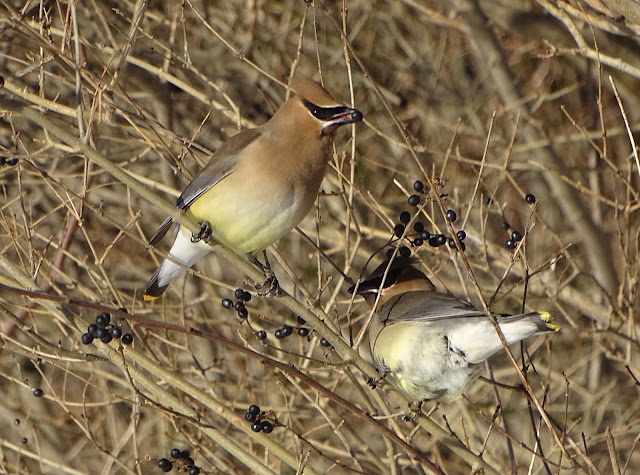In one of the relationships that undergirds nature as we know it, berries produced by trees, shrubs and vines sustain the birds who help distribute those woody plants far and wide. Typically the birds help themselves to the calories and nutrients in the surrounding pulp package and excrete the hard, undigested seeds to the random fortunes of dispersal. Even birds that are insectivores by preference get through the lean season at Halibut Point by eating berries.
 |
Robin and cedar
berry, Juniperus virginiana |
Flocks of Robins that we used to associate with the arrival of spring are now sustaining themselves through the winter on a variety of landscape resources.
 |
| Cardinal eating cedar berries |
Cardinals have similarly found sufficient food to pioneer a year-round New England presence within recent decades.
 |
Yellow-rumped Warbler |
Some Yellow-rumped Warblers have extended their stay locally with help from cedar berries.
 |
Starling with cedar berry |
Many species in addition to the Cedar Waxwing depend partially on these trees for winter sustenance.
 |
Robin in Crabapple tree |
Succulent fruits that may not attract birds in the cornucopia of fall become important nutrients later in the season.
 |
Cardinal in Honeysuckle shrub |
Even in their most desiccated state berries retain some food value for the bird population.
 |
White-throated
Sparrow eating Virginia Creeper berries |
For reasons known to themselves birds may be drawn to a particular fruit or tree in preference to an adjacent one.
 |
Cedar Waxing reaching for Multiflora Rose berries |
 |
Cedar Waxwings eating Privet berries |
The fact that so many non-native species have been spread by seed dispersal through Halibut Point is proof of the palatability of their berries to birds.
 |
Robin plucking Sumac fruit |
The source of some meals might be surprising to us, but the birds know what they need and where to find it.
 |
Bittersweet |
Bittersweet berries look like
an obvious sustainer but at this point in the season they have drawn relatively
little attention. They may have a bigger role to play as winter deepens.
 |
Yellow-breasted Chat amid Bittersweet |
Bittersweet did attract my own first sighting at Halibut Point of this warbler relative and its astonishing glint of chromium yellow on a drab chilly day.





























